Ronald B. Hammond
Ohio Agricultural Research and Development Center
The Ohio State University
Wooster, OH 44691-3686

Soybean, Glycine max (L.) Merr., has been an important field crop in the U.S. since the 1940s because of its value as a animal feed crop and for its edible and industrial uses. Soybean meal is the protein choice for livestock and poultry producers worldwide, commanding nearly 87% of all the oilseed meals used by the feed industry. Soybean oil dominates the edible oil market, with uses in salad and cooking oil, baking and frying oil, margarine, and mayonnaise. In industrial use, soybean oil is used in paints, coatings, cosmetics, and printing ink to name but a few.
With the U.S. growing about half of the world's production of soybean, it has been a major agricultural export since the 1970s. Whereas early soybean growers did not usually have serious insect problems, nowadays they often experience significant losses from insect pests. Many insects have reached major pest status on soybean with additional ones attacking the crop every year. Insect pest management has become an important part of crop production in most soybean-growing states and localities.
The Soybean Plant
Prior to understanding soybean insect IPM comes the need to know the crop plant and its growth throughout the season. Many decisions that a grower or IPM practitioner will make depends upon the type of soybean and the plant's growth stage.
The first important classification is that of maturity group. Soybean flowering and maturing is dependent upon daylength which is governed by latitude. As one goes farther north, summer daylength increases, and cultivars developed for northern latitudes are necessary for the plant to flower. Maturity groups range from Group 00 in the far north to Group VIII along the Gulf Coast Region, with soybean cultivars grown in southern Florida being of Group IX. In the Midwest, maturity groups range from Group I in southern Minnesota to Group IV in southern Missouri, Illinois, Indiana, and Ohio.
Associated with maturity group is the manner in which the stem grows and flowering is initiated. Most northern-adapted cultivars have an indeterminate growth pattern; the terminal bud continues in vegetative activity throughout the season and the plant continues to add leaf material after flowering. Most cultivars grown in the south have a determinate growth pattern; vegetative growth ceases after flowering. A primary difference between the two is that indeterminate cultivars have the ability to compensate for leaf loss by continually adding new leaf material throughout the season.
For IPM purposes, growth stage is the most important criterion because the relationship between insect injury and crop damage is dependent on the stage when the injury occurs. Researchers have determined that injury during the vegetative stages is usually not as detrimental to the plant as that during reproductive stages. The preferred index is based on whether the plant is in a vegetative or reproductive stage. The following is the system currently used, with V representing vegetative stages and R reproductive stages:
| Vegetative Stages | Reproductive Stages |
|---|---|
|
VE emergence |
R1 beginning bloom |
|
VC cotyledon + unfolding unifoliate |
R2 full bloom |
|
V1 first-node trifoliate |
R3 beginning pod |
|
V2 second-node trifoliate |
R4 full pod |
|
V3 3rd-node trifoliate |
R5 beginning seed |
|
V4 4th-node trifoliate |
R6 full seed |
|
V5 5th-node trifoliate |
R7 beginning maturity |
|
Vn Nth-node trifoliate |
R8 full maturity |
Because soybean response to insects is dependent upon the growth stage, economic thresholds vary with the stage. Thus, it is imperative that growers and IPM practitioners recognize these developmental stages.
Insect Problems in Soybean

Insect problems in the U.S. generally follow a south to north line in terms of severity. Insect pressure is greatest in southern states, with lesser amounts in the more middle regions of the country; generally they are much less severe in the north central states. While economic insect problems were quite rare in the northern states during the 1970s, they have become more frequent since the 1980s. For example, Mexican bean beetle, Epilachna varivestis Mulsant, caused serious damage in the eastern portions of the Midwest during the 1980s, and more recently, bean leaf beetles, Cerotoma trifurcata (Forster), has become a problem throughout the Midwest in the later 1980s and early 1990s. The north has also experienced significant outbreaks from other pests that are usually considered infrequent problems, such as the widespread outbreak of twospotted spider mites, Tetranychus urticae Koch, in 1988.
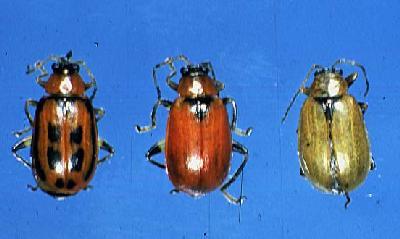
An important difference between the regions is that when problems occur in Midwestern states, much larger acreage is often affected making the problem that much greater. In 1988 for example, the twospotted spider mites referred to above damaged millions of acres in Midwest. Even the problems with Mexican bean beetles in the early 1980s, and more recently, bean leaf beetles, covered more acres than problems often do in the south.
Although researchers have a good understanding of the current insect problems, they are ever aware of potential pests that might occur in the future as growers adopt new and different practices. A change in grower practices might cause different insects to become problems or alter insect-injury/plant relationships. For example, a practice gaining acceptance in the U.S., especially in the Midwest, is conservation tillage which leaves over 30% crop residue remaining on the soil surface. These systems can significantly alter an insect's habitat and can cause changes in population dynamics of a pest. It should be noted that changes in these production practices may also affect the various natural enemies that are present. Current thought is that we are not seeing significant changes in the insect pest situation in soybean with conservation tillage; the only pest that has increased in severity are slugs which are causing grower concern in the eastern Midwest where conservation tillage has been used for a longer period of time (although slugs are not insects, entomologists usually deal with them).
Another practice gaining wider acceptance is the use of narrow or solid-seed rows; rather than planting soybean in 30 in rows, growers use a drill to plant in row widths of 7 and 15 in. Although not appearing to have a direct impact on insect population dynamics, row width might have an impact on insect-injury/plant-response relationships which might alter economic injury levels. Research on row widths and plant response to defoliation is currently being conducted.
A grower philosophy that is gaining acceptance is alternative agriculture. Although not specific grower practices, alternative agriculture places a greater emphasis on preventive pest management tactics and away from reliance on insecticides. Preventive tactics will make more use of cover crops, trap crops, resistant cultivars, and other cultural practices which the grower might employ specifically for pest management. Their use will demand a much better understanding of the biology and life history of insect pests.
Major Insect Fauna
Defoliators
Major insect fauna associated with soybean are often grouped according to the injury caused. The first group to consider are the defoliators which consume leaf tissue. From northern to southern locations, important defoliators include the green cloverworm, Plathypena scabra (F.), the bean leaf beetle, the Mexican bean beetle, the velvetbean caterpillar, Anticarsia gemmatalis (Hübner), and the soybean looper, Psuedoplusia includens (Walker). Only the first three pests are found in the Midwest, and at most, cause infrequent problems; however as mentioned earlier, this can be over large areas.
The velvetbean caterpillar and soybean looper are considered major pests in the southern states and can cause significant injury to soybean yearly.
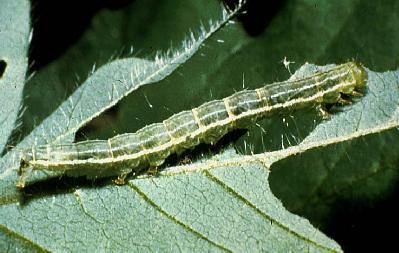
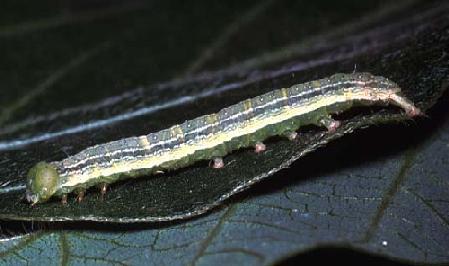
Pod feeders

The second group of pests are the pod feeders. The only insect associated with pod injury on a regular basis in the Midwest is the bean leaf beetle. Bean leaf beetles defoliate the plant during the early and middle portions of the growing season; it is the last generation of beetles in late summer and early fall that changes its feeding habit and feeds on the pod. This injury can cause significant yield reductions, and in some Midwest states, lowering of seed quality because of entrance of seed pathogens via feeding scars. Southern states have significant pod-damage problems with the corn earworm, Helicoverpa zea (Boddie), and a stink bug complex that includes the southern green stink bug, Nezara viridula (L.), the green stink bug, Acrosternum hilare (Say), and to a lesser extent the brown stink bug, Euschistus servus (Say).

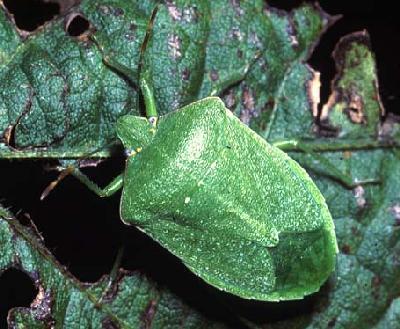
Stem Feeders and Girdlers
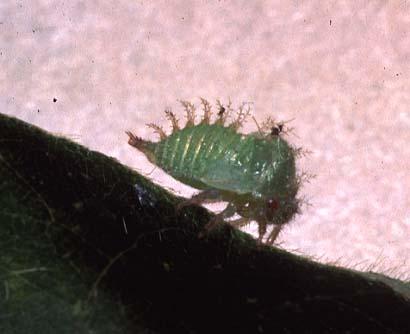
The final grouping of insect pests are those that feed on or girdle the stem. Only one pest of significance causes this type of injury to a large degree, the threecornered alfalfa hopper, Spissistilus festinus (Say); this is a pest of more southern states.
Other Insect Fauna
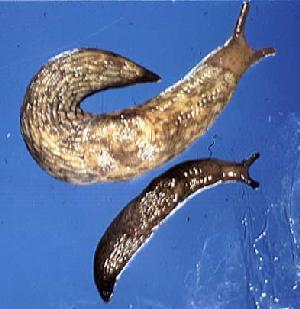
Numerous other insects can cause significant injury that requires therapeutic applications of insecticides; these problems are often on a state, regional, or local level. Although not considered "major" pests, insects in this category nevertheless cause much concern to growers experiencing the problem which dictates involvement by researchers, extension agents, and other IPM practitioners in their management.
Notable pests in this group in northern states are twospotted spider mites, seedcorn maggots, Delia platura (Meigen), potato leafhoppers, Empoasca fabae (Harris), Japanese beetles, Popillia japonica Newman, grasshoppers including the redlegged, Melanoplus femurrubrum (De Geer), and differential grasshopper, Melanoplus differentialis (Thomas), and various slug species, including the gray garden, Derocerus reticulatum (Müller), the marsh, Derocerus laeve (Müller), and the dusky slug Arion subfuscus (Draparnaud).
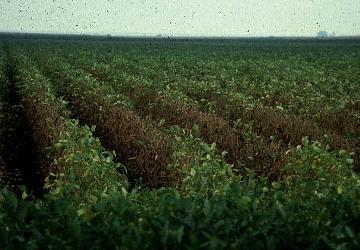
Of those listed, special note should be made of twospotted spider mites and slugs. Twospotted spider mites are considered infrequent pests, generally causing damage along the edge of a field in later summer during periods of drought. However, as a result of a severe drought in the Midwest in 1988 that began in early spring, the twospotted spider mite reached astronomical proportions, causing damage to millions of acres and costing Midwestern growers tens of millions of dollars in losses and management costs. As mentioned earlier, slugs are a new concern with the adoption of conservation tillage practices. Although most slug problems are currently limited to the eastern corn belt, scattered reports of slug injury to soybean are being reported elsewhere in the midwest. Slugs are a concern which will need to be monitored in the coming years as conservation tillage, especially no-tillage, increases in the north central region.
Economic Injury Levels
Economic injury levels are covered elsewhere on this Web Site. However, a few comments on EILs on soybean are appropriate because this crop was one of the first to have benefited from their use. Prior to the development of EILs for soybean insects, applications of insecticides were often made at the mere sight of an insect population. With the calculation of EILs in the early 1970s based on knowledge of insect feeding and development, the plant's response to defoliation, economic costs associated with insecticide application and price of soybean, growers gained the knowledge that moderate insect populations could be tolerated without insecticides being needed. The use of insecticides in some states dropped dramatically after EILs became available. The most important aspect with the relationship between insect injury and crop response is that soybean has a tremendous ability to compensate for low levels of defoliation or reduced plant stand. This natural tolerance allows growers to accept some injury knowing that yield losses will not occur.
Although there is much work left in refining EILs, they are used in all soybean growing states. Because of local conditions, growers are always advised to contact local extension offices to obtain information for their given situation. Generally, insecticide treatments are not necessary until defoliation reaches >50% in the vegetative stages, 15-10% during the flowering (R1-R2), pod development (R3-R4), and pod fill (R5) stages, and >25% from podfill (R6) to harvest. Some states use information on insect leaf-tissue consumption and present EILs as the number of insects per known unit, such as number of insects per linear foot, or number per sweeps.
Insect Injury to Soybean
While research efforts in developing EILs usually have dealt with each insect as an individual pest, recent efforts have been directed towards developing a more comprehensive approach to how insects injure the plant. Since we are concerned with the plant, researchers are discussing the plant part that is injured; thus, insects are being grouped into leaf feeders, stem feeders, pod feeders. EILs based on insect guilds grouped according to the plant part injured attempt to present growers with useable levels based on the complex of insects that might be in their fields. However, this approach has a shortcoming because all insects might not produce comparable responses by the plant. For example, green cloverworm larvae consume large amounts of tissue, while Mexican bean beetle scrape the surfaces of the leaves.
A more recent approach has been to categorize injury on how it impacts plant physiology. Thus, insects are being categorized as to the injury they cause, such as stand reduction, leaf mass removal, leaf photosynthetic-rate reduction, light reduction, seed or fruit destruction, to name a few. Injury to the plant leads to plant or crop damage, which is defined as a measurable reduction in plant growth, development or yield loss. By gaining a better understanding of these relationships, researchers hope to develop more useful EILs based on crop injury.
Detection of Problem
Much work has occurred in soybean on sampling for insects and measurement of injury. An excellent reference is the book "Sampling Methods in Soybean Entomology" listed in the references. A brief description of IPM-related techniques follow.
When assessing an insect population, a sampling technique is used that is appropriate for the insect in question and the stage of the plant. Direct observation on the plant during the early stages of growth in the spring is considered the best option due to the plant's small size. These in situ samples are very appropriate for early season pests such as the bean leaf beetle and Mexican bean beetle, and slugs (albeit that slugs are best observed at dusk). As the plant reaches sufficient size, most IPM programs suggest the use of a ground or shake cloth, or a sweep net. A ground or shake cloth, while more cumbersome than a sweep net, often gives near absolute counts of insects such as caterpillars (e.g., green cloverworm) or other non-flying larvae (e.g., Mexican bean beetle). However, other insects are difficult to sample with a shake cloth because they tend to fly away when disturbed (e.g., bean leaf beetle adults). For most insects, a sweep net is used where a net is swept through the plant canopy a given number of times and then the insects are counted. Sweep nets are also less cumbersome and time consuming to use, and allow for larger areas of the field to be sampled in a much shorter period of time. Although sweep nets provide insect counts that are considered at best relative to the size of the population and vary with size of the plants and the person doing the sweeping, they are usually considered the most appropriate insect-sampling technique in IPM programs.
Often the injury caused by the insect can be measured; for example, defoliation levels are estimated, percent pod injury is calculated, or percent stand reduction is determined. These measurements are quite useful in determining when an EIL is being reached. However, it is still advisable to confirm the presence of an insect pest before making any insecticide application.
Most IPM guidelines suggest the frequency of sampling to allow for efficient use of time. Recommendations often advise at least weekly sampling during the growing season. Examinations of plant injury combined with insect sampling will allow for the identification of a potential pest population. As an insect population develops, more frequent sampling is often recommended; numerous insects have the capacity to reach large, damaging populations very quickly and weekly sampling is often too long to go between field visits.
Management Tactics
When the EIL is reached, a therapeutic tactic is needed to prevent further injury to the plant; the only such tactic currently available is the use of an insecticide. However, it should be noted that past and current research in soybean has done much in lowering the amount of an insecticide's active ingredient that must be applied. During the 1960s and 1970s, rates of 1-2 lb. [AI]/acre for many insecticides were common; research got those rates down to levels of 0.5 to 0.75 lb. [AI]/acre. With the newer pyrethroid insecticides, we are seeing rates of 0.01 lb. [AI]/acre and lower.
Much work has been done in developing preventive tactics which are designed to lower the overall insect population or increase the carrying capacity of the plant. Although not always sufficient to maintain pests below economic levels, we realize the important contribution of natural enemies such as predators, parasitoids, and pathogens, in the biological control of insect pests. With the green cloverworm for example, we know that a naturally occurring pathogen plays a major role in controlling outbreaks.
There are efforts underway to develop soybean cultivars that are resistant to insects. Currently, only a few cultivars have been released to growers; however, these are all adapted to southern locations (the cultivars being group VII and VIII). Numerous programs in the Midwest are active in developing northern adapted cultivars; numerous germplasm lines with high levels of resistance have been developed, but they are currently yielding lower than is necessary for release as cultivars.
Numerous cultural tactics are being examined and recommended. Manipulating planting date is useful in the Midwest for management of overwintering pests such bean leaf beetles and Mexican bean beetles. The adults of both insects leave their overwintering sites in mid-spring and tend to enter earlier planted soybean fields. Thus, late planting is suggested as a management tactic for both these pests.
Related to early planting is the use of trap crops, where a more preferred crop that attracts the pest is planted near a soybean field. Although trap cropping has been more useful in southern states, efforts were made in the 1980s to use early planting of more-preferred green bean as a trap crop against the Mexican bean beetle.
Another preventive tactic being actively explored is planting cultivars of different maturity than would normally be grown in an area. When cultivars of differing maturities are present, insects will often prefer one cultivar over another. Thus, a grower attempts to pass through a susceptible crop-growth stage before an insect reaches damaging numbers. This idea is being examined in southern states as a way to manage the stink bug complex.
Integration with Other Pest Disciplines
IPM philosophy suggests integration with other pest disciplines (diseases, weeds, and nematodes). Although research in truly integrated programs is farther along in soybean than in other crops, there is still much work to do. Currently, most recommendations for a pest do NOT consider the presence and/or the impact of other pest types. A barrier to the full integration is the lack of an understanding of the plant responses to all types of injury. Determining that injury from an insect pest might possibly affect the physiology of the plant similar to a plant pathogen or weed would go far in development truly integrated approaches to pest management. As researchers begin to better understand the impact of injury from all pests on the plants' physiology, they then will be able to develop unified approaches to the management of pests.
References
- Kogan, M., & D. C. Herzog. 1980. Sampling Methods in Soybean Entomology. Springer- Verlag, New York. pp. 587.
- Hammond, R. B., R. A. Higgins, T. P. Mack, L. P. Pedigo, & E. J. Bechinski. 1991. Soybean pest management, pp. 341-472 In CRC Handbook of Pest Management in Agriculture, 2nd Edit. D. Pimentel, Ed. CRC Press, Inc. Boca Raton, FL.
- Higley, L. G., & D. J. Boethel. 1994. Handbook of Soybean Insect Pests. Entomol. Soc. Amer. pp. 136.